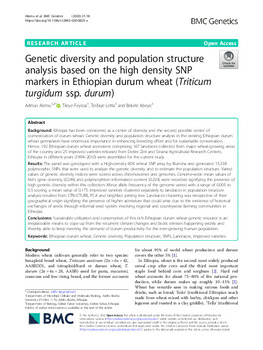Mostrar el registro sencillo del ítem
Genetic diversity and population structure analysis based on the high density SNP markers in Ethiopian durum wheat (Triticum turgidum ssp. durum)
| Autor: | Alemu, A. |
| Autor: | Feyissa, T. |
| Autor: | Letta, T. |
| Autor: | Abeyo Bekele Geleta |
| Año: | 2020 |
| ISSN: | 1471-2156 (Print) |
| URI: | https://hdl.handle.net/10883/20769 |
| Formato: | |
| Lenguaje: | English |
| Editor: | BioMed Central |
| Copyright: | CIMMYT manages Intellectual Assets as International Public Goods. The user is free to download, print, store and share this work. In case you want to translate or create any other derivative work and share or distribute such translation/derivative work, please contact CIMMYT-Knowledge-Center@cgiar.org indicating the work you want to use and the kind of use you intend; CIMMYT will contact you with the suitable license for that purpose. |
| Tipo: | Article |
| Lugar de publicación: | London (United Kingdom) |
| Número: | 1 |
| Número: | art. 18 |
| Volumen: | 21 |
| DOI: | 10.1186/s12863-020-0825-x |
| Descripción: | Background: Ethiopia has been considered as a center of diversity and the second possible center of domestication of durum wheat. Genetic diversity and population structure analysis in the existing Ethiopian durum wheat germplasm have enormous importance in enhancing breeding effort and for sustainable conservation. Hence, 192 Ethiopian durum wheat accessions comprising 167 landraces collected from major wheat-growing areas of the country and 25 improved varieties released from Debre Zeit and Sinana Agricultural Research Centers, Ethiopia in different years (1994–2010) were assembled for the current study. Results: The panel was genotyped with a High-density 90 K wheat SNP array by Illumina and generated 15,338 polymorphic SNPs that were used to analyze the genetic diversity and to estimate the population structure. Varied values of genetic diversity indices were scored across chromosomes and genomes. Genome-wide mean values of Nei’s gene diversity (0.246) and polymorphism information content (0.203) were recorded signifying the presence of high genetic diversity within this collection. Minor allele frequency of the genome varied with a range of 0.005 to 0.5 scoring a mean value of 0.175. Improved varieties clustered separately to landraces in population structure analysis resulted from STRUCTURE, PCA and neighbor joining tree. Landraces clustering was irrespective of their geographical origin signifying the presence of higher admixture that could arise due to the existence of historical exchanges of seeds through informal seed system involving regional and countrywide farming communities in Ethiopia. Conclusions: Sustainable utilization and conservation of this rich Ethiopian durum wheat genetic resource is an irreplaceable means to cope up from the recurrent climate changes and biotic stresses happening widely and thereby able to keep meeting the demand of durum productivity for the ever-growing human population. |
| País: | ETHIOPIA |
| Agrovoc: | HARD WHEAT |
| Agrovoc: | GENETIC DIVERSITY |
| Agrovoc: | POPULATION STRUCTURE |
| Agrovoc: | SINGLE NUCLEOTIDE POLYMORPHISM |
| Agrovoc: | LAND RACES |
| Agrovoc: | VARIETIES |
| Datasets relacionados: | https://bmcgenet.biomedcentral.com/articles/10.1186/s12863-020-0825-x#Sec18 |
| Revista: | BMC Genetics |
Ficheros en el ítem
Este ítem aparece en la(s) siguiente(s) colección(ones)
-
Wheat
Wheat - breeding, phytopathology, physiology, quality, biotech

